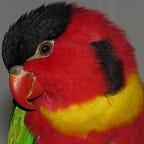Watch: How A Frog Is Helping Scientists Understand A Deadly Amphibian Pandemic
Recent field experiments focusing on a tiny, charismatic frog in southeastern Brazil are beginning to shed light on a disease that has decimated amphibian populations around the world.
© by GrrlScientist for Forbes | LinkTr.ee
The diminutive red pumpkin toadlet, Brachycephalus pitanga, is a brightly colored species of frog in the family Brachycephalidae. It is tiny but nevertheless, its brilliant reddish-orange color draws attention to it and serves as a visual warning to would-be predators that eating it would be a grave mistake.
As a result, this tiny poisonous toadlet lives unmolested in the lush mosses and leaf litter of the Atlantic rainforest on Brazil’s southeast coast, just 50 kilometers south of Brazil’s largest city, Sao Paulo. Although very common where they occur, these toadlets have a limited distribution. Two of the four known localities where these frogs are found are protected by the Serra do Mar State Park.
Despite its tiny size, this amphibian is having an outsized effect on science. The red pumpkin toadlet is an important scientific model that is helping those who study the chytrid fungus (Batrachochytrium dendrobatidis [Bd]) to better understand its dynamics. Chytrid is the deadly amphibian fungus that has killed countless populations of frogs and toads around the world. It has been estimated that chytrid disease has contributed to the decline of more than 500 amphibian species and led to as many as 90 extinctions globally.
Currently, a team of researchers in Brazil and in the United States is hard at work trying to understand how this fungus can spread through a population of amphibians and what influences the severity of the disease it causes. For example, one particularly intriguing aspect of chytrid is that is can wipe out an entire population of amphibians whereas it may cause only sporadic deaths in others. Why?
But amphibians may be fighting back. During their studies, the researchers identified some individual toadlets that appeared to recover from the disease on their own. What makes these tiny frogs so special? Could these special frogs teach us what we can do to help protect other frogs around the world?
Learn more about these amazing little frogs and the research they are contributing to in this video.
Produced by videographer Katie Garrett and bioGraphic, a video magazine about nature and biodiversity powered by the California Academy of Sciences.
